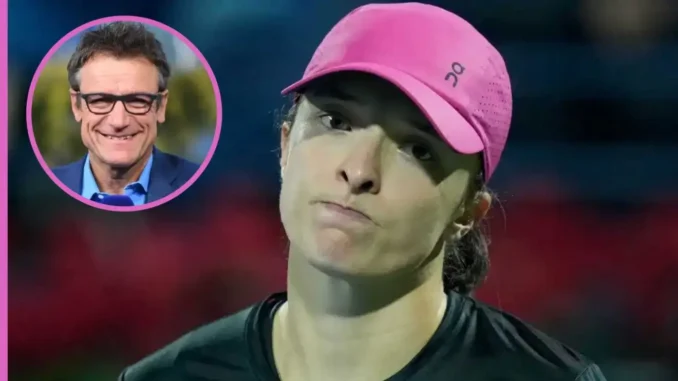
In the high-stakes world of professional tennis, where every match is a battle of skill, strategy, and willpower, Iga Swiatek stands as one of the game’s brightest stars. The Polish phenom, a five-time Grand Slam champion at just 23 years old, has dominated the WTA Tour with her relentless baseline game and unparalleled clay-court prowess. Yet, as the 2025 season unfolds, a former world No. 1 has sounded the alarm on what she sees as a glaring vulnerability in Swiatek’s otherwise formidable arsenal—a flaw that her rivals are beginning to exploit with alarming success.
Swiatek’s rise to the top has been nothing short of meteoric. Since bursting onto the scene with her stunning 2020 French Open triumph, she’s racked up four titles at Roland Garros and a US Open crown, cementing her status as a generational talent. Her game, built on a devastating topspin forehand and tireless movement, has often left opponents scrambling for answers. But as the competition adapts, a chink in her armor has emerged, one that could threaten her reign if left unchecked. “She’s phenomenal, no doubt,” the former top-ranked player remarked, her tone a mix of admiration and analysis, “but there’s a big problem she’s facing now, and her opponents are starting to figure it out.”
The issue, according to this seasoned observer, lies in Swiatek’s inflexibility under pressure. When her Plan A—overpowering foes with precision and pace—falters, she struggles to pivot. It’s a subtle but critical weakness, one that’s been exposed in recent months against players willing to take risks and disrupt her rhythm. “She tries to dominate every point, which works against most of the tour,” the ex-champion explained. “But when someone steps up and matches her intensity or throws something unexpected her way, she doesn’t always have a backup. She keeps hitting harder, and that’s when the errors creep in.” This observation isn’t just armchair critique—it’s a blueprint that’s already yielding results for Swiatek’s challengers.
Take her latest encounters: a string of losses to players like Jelena Ostapenko, who boasts a perfect 5-0 record against her, and Mirra Andreeva, the teenage prodigy who’s twice toppled her this year. These defeats share a common thread—opponents who refuse to be dictated to, who absorb Swiatek’s power and redirect it with aggression or variety. Ostapenko, with her fearless ball-striking, has turned their matchups into a personal nightmare for Swiatek, while Andreeva’s crafty play has unraveled the Pole’s game in clutch moments. “I’ve seen it too many times now,” the former No. 1 noted. “She’s got all the tools, but when the momentum shifts, she doesn’t adjust—she doubles down, and it’s costing her.”
This critique comes at a pivotal moment for Swiatek. After a stellar first half of 2024, where she claimed her third straight French Open title, her form dipped. A doping suspension—later attributed to contaminated melatonin— sidelined her for a month, stripping her of the No. 1 ranking she’d held with an iron grip. Returning in 2025, she’s shown flashes of brilliance, like her near-flawless run to the Australian Open semifinals, only to falter against Madison Keys in a heartbreaker. “Sometimes I felt like my decisions weren’t really perfect on the court,” Swiatek herself admitted earlier this year, reflecting on those moments when her game unraveled. “I started playing, you know, too flat.”
The former world No. 1 believes this rigidity could be Swiatek’s Achilles’ heel on surfaces beyond her beloved clay. While her clay-court mastery—where her spin and stamina reign supreme—seems untouchable, hard courts and grass expose her discomfort with improvisation. “She’s made for clay,” the ex-pro said, pointing to Swiatek’s four French Open titles. “But on faster surfaces, where you can’t just grind it out, she needs more layers. The top players are seeing that now.” It’s a sentiment echoed in the tennis world, where analysts have begun to question whether Swiatek can reclaim her dominance without evolving.
Yet, there’s hope in the narrative. Swiatek’s new coach, Wim Fissette, a veteran tactician who’s guided stars like Naomi Osaka and Angelique Kerber to Grand Slam glory, could be the key to unlocking that adaptability. Their partnership, still in its infancy, has already hinted at progress—her Australian Open campaign showed a willingness to mix up her play, even if the results didn’t fully materialize. “We’re working in a different way a little bit, getting back to my roots,” Swiatek said of their collaboration, suggesting a conscious effort to broaden her game.
As the season marches toward the clay swing, where Swiatek will again be the favorite, the question looms: can she shore up this “big problem” before her rivals exploit it further? At 23, with a career already studded with accolades, she has time on her side. But in a sport where the margins are razor-thin, adaptation could be the difference between a good year and a great one. For now, the tennis world watches, waiting to see if the Polish powerhouse can rewrite the script—or if her opponents will keep turning her strength into their opportunity.
Leave a Reply